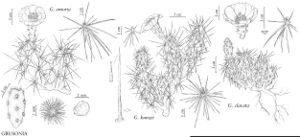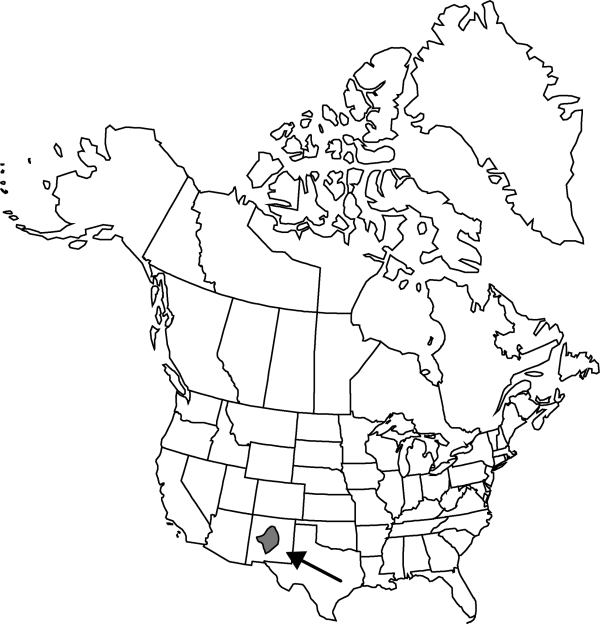Difference between revisions of "Grusonia clavata"
Phytologia 26: 176. 1973.
FNA>Volume Importer |
imported>Volume Importer |
||
| (7 intermediate revisions by 2 users not shown) | |||
| Line 8: | Line 8: | ||
}} | }} | ||
|common_names=Club-c holla | |common_names=Club-c holla | ||
| − | |basionyms={{Treatment/ID/ | + | |special_status={{Treatment/ID/Special_status |
| + | |code=F | ||
| + | |label=Illustrated | ||
| + | }}{{Treatment/ID/Special_status | ||
| + | |code=E | ||
| + | |label=Endemic | ||
| + | }} | ||
| + | |basionyms={{Treatment/ID/Basionym | ||
|name=Opuntia clavata | |name=Opuntia clavata | ||
|authority=Engelmann | |authority=Engelmann | ||
| + | |rank=species | ||
| + | |publication_title=in F. A. Wislizenus, Mem. Tour N. Mexico, | ||
| + | |publication_place=95. 1848 | ||
}} | }} | ||
|synonyms={{Treatment/ID/Synonym | |synonyms={{Treatment/ID/Synonym | ||
|name=Cactus clavatus | |name=Cactus clavatus | ||
|authority=(Engelmann) Lemaire | |authority=(Engelmann) Lemaire | ||
| − | }}{{Treatment/ID/Synonym | + | |rank=species |
| + | }} {{Treatment/ID/Synonym | ||
|name=Corynopuntia clavata | |name=Corynopuntia clavata | ||
|authority=(Engelmann) F. M. Knuth | |authority=(Engelmann) F. M. Knuth | ||
| + | |rank=species | ||
}} | }} | ||
|hierarchy=Cactaceae;Cactaceae subfam. Opuntioideae;Grusonia;Grusonia clavata | |hierarchy=Cactaceae;Cactaceae subfam. Opuntioideae;Grusonia;Grusonia clavata | ||
| Line 26: | Line 38: | ||
}}<!-- | }}<!-- | ||
| − | --><span class="statement" id="st- | + | --><span class="statement" id="st-undefined" data-properties=""><b>Shrubs,</b> forming mats, widely spreading, 5–15 cm, in series of usually 1–2 stem segments. <b>Roots</b> diffuse. <b>Stem</b> segments short-clavate, strongly narrowed at base, 2.5–5(–7.5) × 1.5–3 cm; tubercles prominent, oval, 5–10(–16) mm, narrow, 4–6 times longer than wide, obscured by interlacing spines; areoles 3 mm in diam.; wool white to gray. <b>Spines</b> 7–15 per areole, primarily in distal areoles; major 3–5 abaxial spines deflexed, white, flattened, longest central spine daggerlike, broadly tapered, 12–35 × 1.5+ mm basally; major 1–3 adaxial spines ascending, white, yellow to tan, angular-flattened to subterete. <b>Glochids</b> in adaxial 1/4 of areole, yellowish white, ± 4 mm. <b>Flowers</b>: inner tepals bright yellow, to 25 mm; filaments light yellow-green to white; style and stigma lobes white. <b>Fruits</b> yellow, barrel-shaped to ellipsoid, 30–45 × 15–25 mm, fleshy, spineless, densely ± yellow-glochidiate; areoles 35–55. <b>Seeds</b> yellowish white, 4.5 × 4 mm, smooth. <b>2n</b> = 22.</span><!-- |
-->{{Treatment/Body | -->{{Treatment/Body | ||
| + | |phenology=Flowering late spring (May–Jun). | ||
|habitat=Great Plains grasslands, open pinyon-juniper woodlands, rocky or sandy soils | |habitat=Great Plains grasslands, open pinyon-juniper woodlands, rocky or sandy soils | ||
|elevation=1800-2500 m | |elevation=1800-2500 m | ||
|distribution=N.Mex. | |distribution=N.Mex. | ||
| − | |discussion=<p>L. D. Benson (1982) mapped | + | |discussion=<p>L. D. Benson (1982) mapped “<i>Opuntia</i> clavata” in northeast Arizona, but no supporting specimens have been found. The report may be based on low-growing specimens of <i>Cylindropuntia whipplei</i>, a cholla common in that area.</p> |
|tables= | |tables= | ||
|references= | |references= | ||
| Line 41: | Line 54: | ||
-->{{#Taxon: | -->{{#Taxon: | ||
name=Grusonia clavata | name=Grusonia clavata | ||
| − | |||
|authority=(Engelmann) H. Robinson | |authority=(Engelmann) H. Robinson | ||
|rank=species | |rank=species | ||
| Line 48: | Line 60: | ||
|basionyms=Opuntia clavata | |basionyms=Opuntia clavata | ||
|family=Cactaceae | |family=Cactaceae | ||
| + | |phenology=Flowering late spring (May–Jun). | ||
|habitat=Great Plains grasslands, open pinyon-juniper woodlands, rocky or sandy soils | |habitat=Great Plains grasslands, open pinyon-juniper woodlands, rocky or sandy soils | ||
|elevation=1800-2500 m | |elevation=1800-2500 m | ||
| Line 54: | Line 67: | ||
|publication title=Phytologia | |publication title=Phytologia | ||
|publication year=1973 | |publication year=1973 | ||
| − | |special status= | + | |special status=Illustrated;Endemic |
| − | |source xml=https:// | + | |source xml=https://bitbucket.org/aafc-mbb/fna-data-curation/src/2e0870ddd59836b60bcf96646a41e87ea5a5943a/coarse_grained_fna_xml/V4/V4_235.xml |
|subfamily=Cactaceae subfam. Opuntioideae | |subfamily=Cactaceae subfam. Opuntioideae | ||
|genus=Grusonia | |genus=Grusonia | ||
|species=Grusonia clavata | |species=Grusonia clavata | ||
| − | |||
| − | |||
| − | |||
| − | |||
| − | |||
| − | |||
| − | |||
| − | |||
| − | |||
| − | |||
| − | |||
| − | |||
| − | |||
| − | |||
| − | |||
| − | |||
| − | |||
| − | |||
| − | |||
| − | |||
| − | |||
| − | |||
| − | |||
| − | |||
| − | |||
| − | |||
| − | |||
| − | |||
| − | |||
| − | |||
| − | |||
| − | |||
| − | |||
| − | |||
| − | |||
| − | |||
| − | |||
| − | |||
| − | |||
| − | |||
| − | |||
| − | |||
| − | |||
| − | |||
| − | |||
| − | |||
| − | |||
| − | |||
| − | |||
| − | |||
}}<!-- | }}<!-- | ||
-->[[Category:Treatment]][[Category:Grusonia]] | -->[[Category:Treatment]][[Category:Grusonia]] | ||
Latest revision as of 21:57, 5 November 2020
Shrubs, forming mats, widely spreading, 5–15 cm, in series of usually 1–2 stem segments. Roots diffuse. Stem segments short-clavate, strongly narrowed at base, 2.5–5(–7.5) × 1.5–3 cm; tubercles prominent, oval, 5–10(–16) mm, narrow, 4–6 times longer than wide, obscured by interlacing spines; areoles 3 mm in diam.; wool white to gray. Spines 7–15 per areole, primarily in distal areoles; major 3–5 abaxial spines deflexed, white, flattened, longest central spine daggerlike, broadly tapered, 12–35 × 1.5+ mm basally; major 1–3 adaxial spines ascending, white, yellow to tan, angular-flattened to subterete. Glochids in adaxial 1/4 of areole, yellowish white, ± 4 mm. Flowers: inner tepals bright yellow, to 25 mm; filaments light yellow-green to white; style and stigma lobes white. Fruits yellow, barrel-shaped to ellipsoid, 30–45 × 15–25 mm, fleshy, spineless, densely ± yellow-glochidiate; areoles 35–55. Seeds yellowish white, 4.5 × 4 mm, smooth. 2n = 22.
Phenology: Flowering late spring (May–Jun).
Habitat: Great Plains grasslands, open pinyon-juniper woodlands, rocky or sandy soils
Elevation: 1800-2500 m
Discussion
L. D. Benson (1982) mapped “Opuntia clavata” in northeast Arizona, but no supporting specimens have been found. The report may be based on low-growing specimens of Cylindropuntia whipplei, a cholla common in that area.
Selected References
None.

